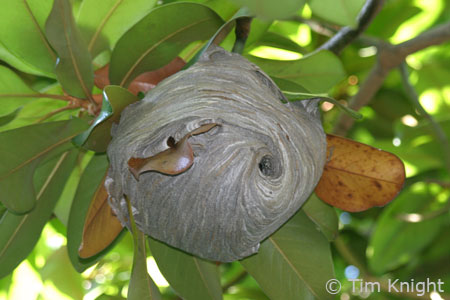

|
Bald-faced Hornet (Dolichovespula maculata) Description: The Bald-faced Hornet is a North American insect that builds a large paper nest to house the social colony. Commonly called the bald-faced hornet (or white-faced hornet), it is not a true hornet. Bald-faced hornets are more closely related to yellow jackets than they are to hornets. These stout-bodied social wasps are black with white markings on the front of the head and the tip of the abdomen. The face in primarily white with dark eyes. Front wings of hornets and other Vespidae are folded lengthwise when at rest. The large antennae are conspicuous. Due to their size, shape and coloration these wasps are sometimes mistaken for bees. Bald-faced Hornets are known for their large ball-shaped paper nest, which they build in the spring for raising their young. These nests can sometimes reach 3 feet tall.
Behavior: Bald-faced Hornets are social insects that live in large colonies. The queen bee, drones and worker bees all have specific tasks to help support the colony. The queen lays hundreds of eggs. The male drones' main function is to be ready to fertilize a receptive queen. Workers do all the different tasks needed to operate and maintain the nest. In late summer, bald-faced hornets visit flowers to collect nectar, so they are known as minor pollinators.
Why wasp sting: All social wasps are capable of producing a painful sting, but none leave the stinger embedded in the skin, as do honey bee workers. Most stings occur when the colony is disturbed. The objective is for the wasps to protect the nest site. In the photo, you can see hornets guarding the entrance. Hornets are very protective of their colony and will attack if someone approaches within a few feet of the nest. When a bee or wasp stings, it injects a venomous fluid under the skin of the victim. Bald-faced Hornets have a smooth stinger, so they can sting more than once. Nest Building: In the spring, the Bald-faced Hornet queen collects wood fiber to make her nest. Some of the fiber can come from a house or fence. The gray paper nest can be found suspended from a tree branch, eaves or other structures. When the nest is finished, it will be the size of a football or basketball. The nest is constructed of paper-like material made from chewed wood fibers mixed with saliva. The bald-faced hornet builds her inner nest with layers of paper cells that look like the honeybee's comb. The nest is composed of 3 or 4 tiers of combs within a thick, layered paper-like outer shell. An opening at the bottom of the nest allows the hornets to fly in and out (see photo). Nests are built every year. The abandoned nest is often destroyed by birds searching for food. Reproduction: Queens are the only members of the colony able to survive the winter. In April or May, each queen selects a suitable location, constructs a small nest and begins raising sterile daughter offspring. These workers take over the duties of enlarging and maintaining the nest, foraging for food and caring for the offspring while the queen functions only to produce more eggs. The queen bee lays all of the eggs in a colony. The queen fertilizes each egg as it is being laid using stored sperm from the spermatheca. The queen occasionally will not fertilize an egg. These non-fertilized eggs, having only half as many genes as the queen or the workers, develop into male drones. The mature colony consists of a queen, 200 to 400 winged infertile female workers, brood (eggs, larvae and pupae) and, in late summer, males and reproductive females.
Did you know?

Bald-face hornet nest suspended in a magnolia tree above a sidewalk in Seattle. More information: |
Animal silhouettes available to purchase »
Photos: Tim Knight; WikipedianProlific (wasp anatomy)
Home | About Us | How to Participate | Biodiversity Modules | Projects | Maps | News | Resources